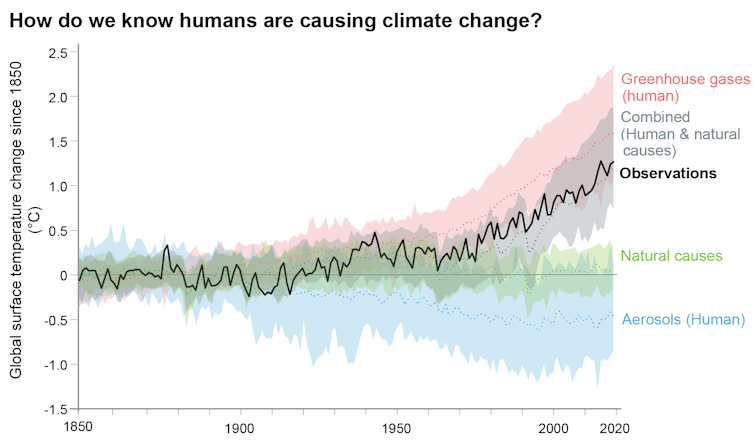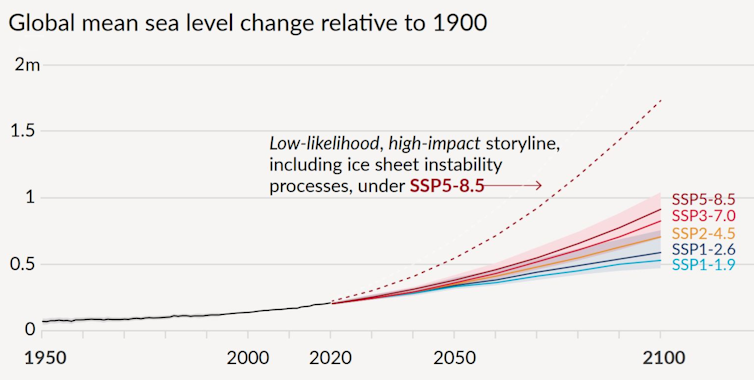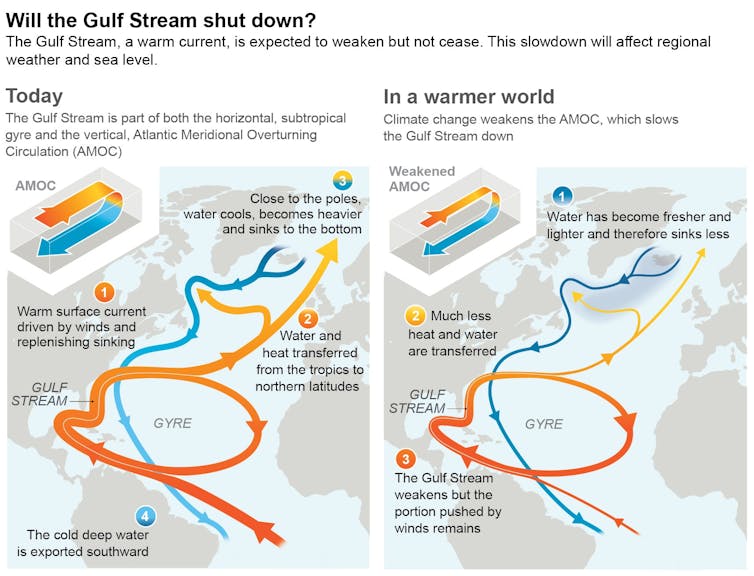[ad_1]
People are unequivocally warming the planet, and that’s triggering speedy adjustments within the environment, oceans, and polar areas, and more and more excessive climate world wide, the Intergovernmental Panel on Local weather Change warns in a brand new report.
The IPCC launched the primary a part of its a lot anticipated Sixth Evaluation Report on Aug. 9, 2021. In it, 234 scientists from across the globe summarized the present local weather analysis on how the Earth is altering as temperatures rise and what these adjustments will imply for the longer term.
We requested local weather scientist Robert Kopp, a lead writer of the chapter on Earth’s oceans, ice, and sea degree rise, concerning the profound adjustments underway.
What are the IPCC report’s most necessary general messages in your view?
On the most simple degree, the info about local weather change have been clear for a very long time, with the proof simply persevering with to develop.
Because of human actions, the planet is altering at a price unprecedented for no less than hundreds of years. These adjustments are affecting each space of the planet.

Whereas a few of the adjustments shall be irreversible for millennia, some may be slowed and others reversed by robust, speedy, and sustained reductions in greenhouse fuel emissions.
However time is operating out to satisfy the formidable aim specified by the 2015 worldwide Paris Settlement to restrict warming to nicely under 2 levels Celsius above preindustrial ranges (2 C equals 3.6 levels Fahrenheit). Doing so requires getting world carbon dioxide emissions on a downward course that reaches net-zero round or earlier than 2050.
What are scientists most involved about proper now on the subject of the oceans and polar areas?
World sea degree has been rising at an accelerating price since about 1970, and over the past century, it has risen greater than in any century in no less than 3,000 years.
Within the years because the IPCC’s Fifth Evaluation Report in 2013 and the Particular Report on the Ocean and Cryosphere in a Altering Local weather in 2018, the proof for accelerating ice sheet loss has turn out to be clearer.
During the last decade, the worldwide common sea degree has risen at a price of about Four millimeters per yr (1.5 inches per decade). This improve is because of two fundamental components: the melting of ice in mountain glaciers and on the poles, and the growth of water within the ocean because it takes up warmth.
Ice sheets specifically are primarily liable for the rise within the price of sea degree rise because the 1990s. There’s clear proof tying the melting of glaciers and the Greenland Ice Sheet, in addition to ocean warming, to human affect. Sea degree rise is resulting in substantial impacts on coastal communities, together with a near-doubling within the frequency of coastal flooding because the 1960s in lots of websites world wide.
For the reason that earlier studies, scientists have made substantial advances in modeling the conduct of ice sheets. On the identical time, we’ve been studying extra about ice sheet physics, together with recognizing the potential methods ice sheets can turn out to be destabilized. We don’t nicely perceive the potential pace of those adjustments, however they’ve the potential to result in rather more speedy ice sheet loss if greenhouse fuel emissions develop unchecked.
These advances verify that the sea degree goes to proceed to rise for a lot of centuries to return, creating an escalating risk for coastal communities.
Sea degree change by 2050 is basically locked in: No matter how rapidly nations are in a position to decrease emissions, the world is probably going taking a look at about 15 to 30 centimeters (6 to 12 inches) of world common sea degree rise by the center of the century.
However past 2050, sea degree projections turn out to be more and more delicate to the world’s emissions decisions. If nations proceed on their present paths, with greenhouse fuel emissions more likely to deliver 3-Four C of warming (5.4-7.2 F) by 2100, the planet shall be taking a look at a most definitely sea degree rise of about 0.7 meters (a bit over 2 ft). A 2 C (3.6 F) hotter world, per the Paris Settlement, would see decrease sea degree rise, most definitely about half a meter (about 1.6 ft) by 2100.

What’s extra, the extra the world limits its greenhouse fuel emissions, the decrease the possibility of triggering instabilities within the polar ice sheets which might be difficult to mannequin however might considerably improve sea degree rise.
Beneath probably the most excessive emissions situation, we thought of, we couldn’t rule out speedy ice sheet loss resulting in sea degree rise approaching 2 meters (7 ft) by the top of this century.
Happily, if the world limits warming to nicely under 2 C, it ought to take many centuries for sea degree rise to exceed 2 meters – a much more manageable state of affairs.
Are the oceans or ice nearing any tipping factors?
“Tipping level” is a imprecise time period utilized in many various methods by completely different folks. The IPCC defines tipping factors as “essential thresholds past which a system reorganizes, in a method that may be very quick or irreversible” – for instance, a temperature rise past which local weather dynamics commit an ice sheet to huge loss.
As a result of the time period is so imprecise, the IPCC typically focuses on traits of adjustments in a system – for instance, whether or not a system would possibly change abruptly or irreversibly – somewhat than whether or not it matches the strict dynamic definition of a “tipping level.”
One instance of a system that may endure abrupt adjustments is the large-scale sample of ocean circulation often called the Atlantic Meridional Overturning Circulation, or AMOC, of which the Gulf Stream is a component. Paleoclimate proof tells us that AMOC has modified quickly prior to now, and we count on that AMOC will weaken over this century. If AMOC had been to break down, it might make Europe heat extra slowly, improve sea degree rise alongside the U.S. Atlantic coast, and shift storm tracks and monsoons. Nevertheless, most proof signifies that such a collapse is not going to occur on this century.

There’s combined proof for abrupt adjustments within the polar ice sheets, however clear proof that adjustments within the ice sheets may be locked in for hundreds of years and millennia.
If the world succeeds in limiting warming to 1.5 C (2.7 F), we count on to see about 2-Three meters (7-10 ft) of sea degree rise over the subsequent 2,000 years; if the planet continues to heat and reaches a 5 C (9 F) improve, we count on to see about 20 meters (70 ft) over the subsequent 2,000 years.
Some folks additionally talk about summer time Arctic sea ice – which has undergone substantial declines over the past 40 years and is now smaller than at any time prior to now millennium – as a system with a “tipping level.” Nevertheless, the science is fairly clear that there isn’t any essential threshold on this system. Relatively, the summer time Arctic sea ice space decreases roughly in proportion to the rise in world temperature, and if the temperature had been stabilized, we’d count on the ocean ice space to stabilize additionally.
What do scientists know now about hurricanes that they didn’t understand when the final report was written?
For the reason that final IPCC evaluation report in 2013, there was growing proof that hurricanes have grown extra intense, and intensified extra quickly than they did 40 years in the past. There’s additionally proof that hurricanes within the U.S. are transferring extra slowly, resulting in elevated rainfall.
Nevertheless, it’s not clear that that is as a result of results of greenhouse gases – reductions in particulate air pollution have additionally had necessary results.
The clearest impact of world warming is {that a} hotter environment holds extra water, resulting in extra excessive rainfall, like that seen throughout Hurricane Harvey in 2017. Wanting ahead, we count on to see hurricane winds and hurricane rains proceed to extend. It’s nonetheless unclear how the general variety of hurricanes will change.
The report concerned 234 scientists, after which 195 governments needed to agree on the abstract for policymakers. Does that broad vary of views have an effect on the result?
If you’re writing a report like this, a key aim for scientists is to precisely seize factors of each scientific settlement and scientific disagreement.
For instance, with respect to ice sheet adjustments, there are particular processes on which there’s broad settlement and different processes the place the science continues to be rising and there are robust, discordant views. But understanding about these processes could also be crucially necessary for decision-makers making an attempt to handle threat.
That’s why, for instance, we discuss not solely about most definitely outcomes, but in addition about outcomes the place the chances are low or as-yet-unknown, however the potential impacts are massive.
The IPCC makes use of a clear course of to provide its report – the authors have had to answer over 50,000 assessment feedback over the three years we’ve spent writing it. The governments additionally weigh-in, having to approve each line of a concise Abstract for Coverage Makers that precisely displays the underlying evaluation – oftentimes making it clearer within the course of.
I’m more than happy that, as with previous studies, each collaborating authorities has signed off on a abstract that precisely studies the present state of local weather science.
Article by Robert Kopp, Professor, Division of Earth & Planetary Sciences, and Director, Rutgers Institute of Earth, Ocean, and Atmospheric Sciences, Rutgers College
This text is republished from The Dialog below a Artistic Commons license. Learn the unique article.
[ad_2]
Supply hyperlink
